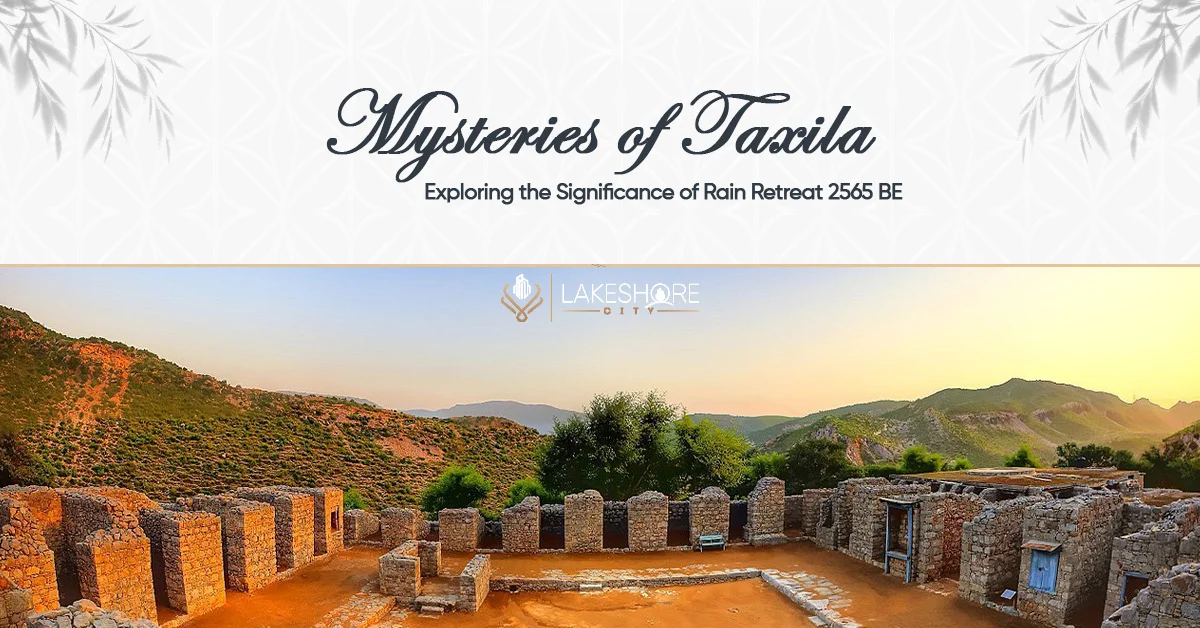Introduction to Ancient City of Taxila
The ancient city of Taxila, now part of Pakistan, is historically highly significant. From roughly the fifth century BCE to the second century CE, it flourished as an essential hub of study, culture, and trade in the Indian subcontinent. Taxila attracted worldwide intellectuals, traders, and travelers because it was a critical intersection between numerous civilizations.
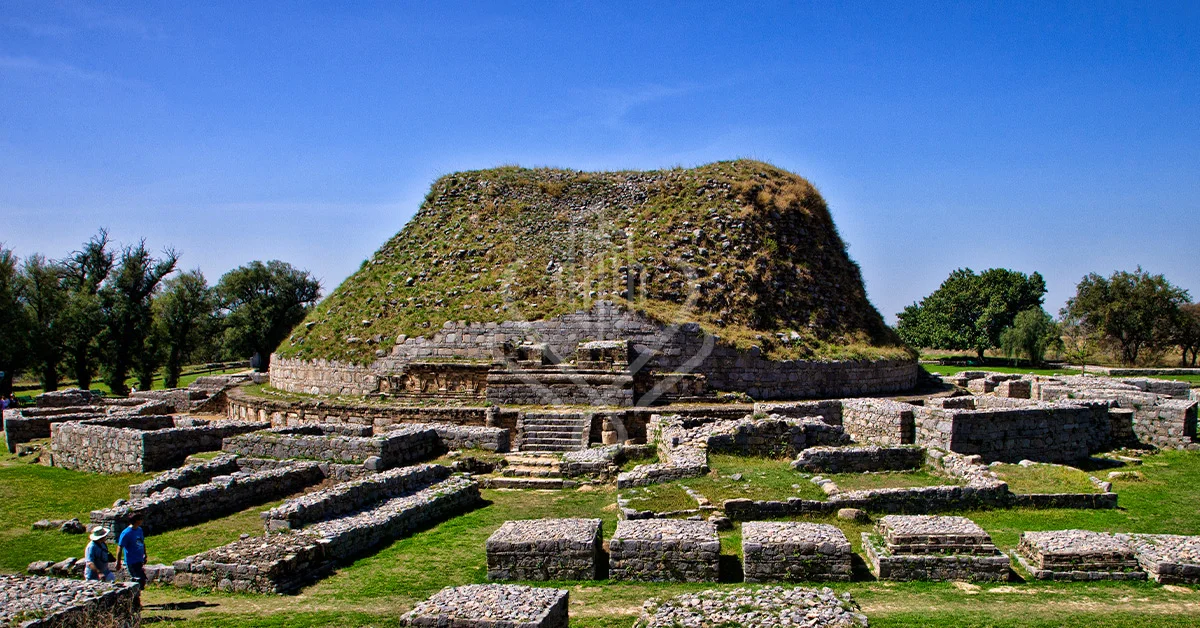
The historical significance of Taxila stems from its function as a thriving center for Buddhism that attracted eminent scholars and promoted the dissemination of Buddhist teachings. The city’s archaeological relics, which include well-preserved monasteries, stupas, and artifacts, have shed important light on the development of Buddhism and ancient Indian civilization. Taxila has been designated as a UNESCO World Heritage Site, protecting its legacy for future generations due to its enormous historical and cultural value.
The Rain Retreat (Vassa) in Buddhist tradition and its importance in the context of Taxila for the year 2565 BE (Buddhist Era)
Vassa, or the Rain Retreat, has great spiritual significance in the Buddhist tradition. Buddhist monks and nuns observe Vassa, three months of monastic retreat, once a year. It usually starts at the eighth lunar month’s full moon and lasts until the eleventh lunar month’s full moon.
Monastic communities congregate for the Rain Retreat to stay put and abstain from travel and other activities that interfere with their spiritual practice. Monks and nuns can focus more on their meditation, study, and reflection during this time, which helps them to grasp Buddhist doctrine better and develop their spiritual discipline. The tradition of Vassa has its roots in the Buddha’s lifetime.

According to legend, in ancient India, the ascetic tradition forbade wandering monks from traveling during the rainy season because they might unintentionally hurt little animals and plants during the wet season. The Buddha founded the Rain Retreat to protect people from harm and aid their spiritual practice. This retreat gave people a chance for in-depth reflection and study.
The Rain Retreat would have been a noteworthy occasion for the local Buddhist monk community in Taxila in the year 2565 BE (Buddhist Era). Taxila’s monks and nuns would have convened in specified monasteries or retreat facilities during this time to observe Vassa together while engaging in intense spiritual practice. That year’s Taxila Rain Retreat would have fostered more communal harmony, study, and purity, strengthening the ties of the monastic order and safeguarding the Buddha’s teachings for future generations.
Ancient City of Taxila in Pakistan
In the foothills of the Himalayas, the historic city of Taxila serves as a reminder of the illustrious past of the Indian subcontinent. Taxila became a thriving center of learning, trade, and culture over two millennia. Taxila flourished as a mash-up of various influences, promoting an environment of intellectual exchange and invention. Taxila served as a vital crossroads connecting the great civilizations of ancient India, Persia, and Central Asia. Its renowned university attracted academics worldwide, making it a significant center for studying philosophy, medicine, science, and the arts.

Well-preserved monasteries, stupas, and sculptures can be found in the city’s archaeological monuments, providing a window into ancient spiritual and cultural practices. The ruins of a bygone era can be explored at Taxila, now a UNESCO World Heritage Site, where tourists can also take in the historical significance of this once-proud metropolis.
Delve into The Historical Background of Taxila, Location, and Role as a Prominent Center of Learning and Culture
An essential place in the history of the Indian subcontinent is occupied by Taxila, an ancient city with a long history that is now in Pakistan. It was first inhabited in the fifth century BCE, making it one of South Asia’s first urban centers. Taxila was a hub for the interchange of ideas, knowledge, and commerce between ancient India, Persia, and Central Asia because of its advantageous location at the intersection of important trade routes. The city benefited from its favorable geographic location, sandwiched between the expansive Hindu Kush mountains and the mighty Indus River.
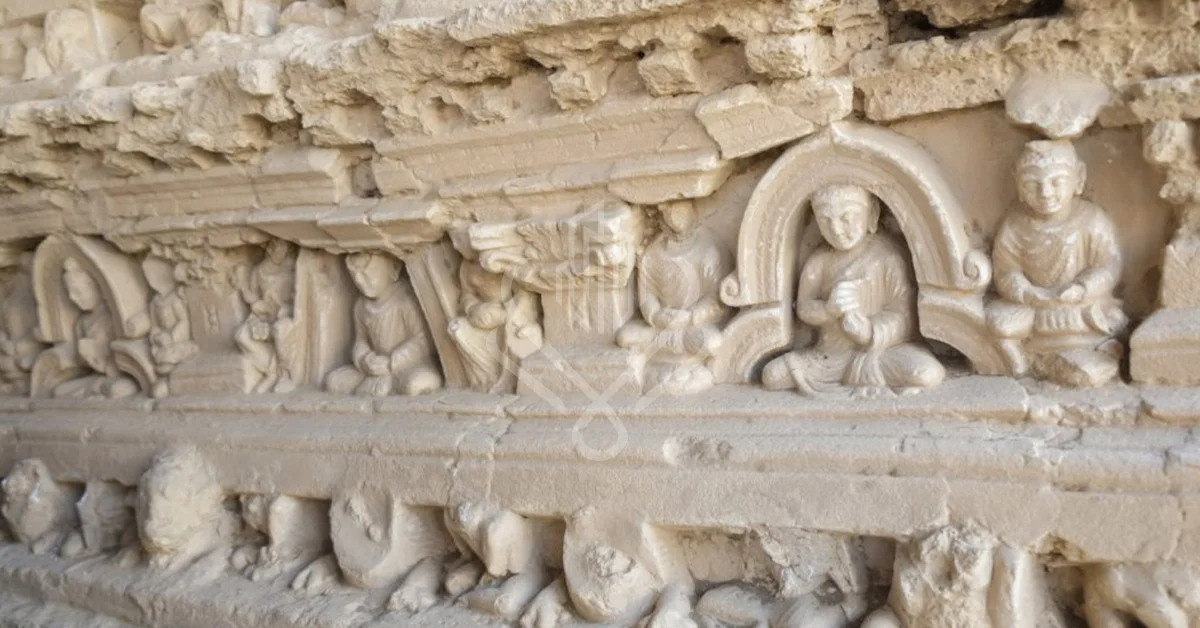
In its day, Taxila was renowned as a hub of learning and culture. A famous university that attracted academics, thinkers, and students from all over the world was located in the city. It was a hub of intellectual curiosity and invention because many subjects were taught here, including philosophy, astronomy, medicine, mathematics, and the arts. Many eminent thinkers flourished in this supportive environment, notably Chanakya (also known as Kautilya or Vishnugupta), who subsequently served as Emperor Chandragupta Maurya’s principal counselor and founded the Maurya Empire.
The presence of Buddhism, which flourished in Taxila and had a lasting impression on the city’s architecture and creative expression, added to the city’s already rich cultural milieu. For many years, Taxila served as a hub of learning and culture, drawing tourists, traders, and thinkers. Although the city saw invasions and later decayed, its historical significance has survived the ages thanks to its ruins and archaeological evidence. A UNESCO World Heritage Site today, Taxila provides modern tourists with a window into the ancient world, the lively exchange of ideas, and the intellectual vitality that once flourished in this storied center of study and culture.
Explore The Ancient Architecture, Monasteries, and Artefacts That Make Taxila a UNESCO World Heritage Site
A UNESCO World Heritage Site, Taxila is home to a diverse collection of historic buildings, monasteries, and artefacts that offer exciting glimpses into ancient times. Visitors are still amazed by the city’s architectural marvels, which feature elaborate designs and expert craftsmanship. The well-preserved monasteries, including those at Taxila’s Dharmarajika, Jaulian, and Mohra Moradu, remind the once-vibrant Buddhist community there. These monastic establishments served as educational institutions and places of devotion and meditation.

Rich stupas, such as the Dharmarajika stupa, acted as sacred reservoirs for artefacts and holy things. The carved stone and sculpted terracotta plaques discovered at these locations portray various events from Buddha’s life and incidents from Jataka stories, illuminating moral lessons and the road to enlightenment. The ancient artefacts in Taxila demonstrate its artisans’ technical mastery and creative flair, from finely carved pillars to intricate stone friezes.
The Buddhist Connection with Taxila
Taxila’s history and cultural heritage are strongly influenced by its ties to Buddhism. From the beginning, Taxila developed into a center for Buddhist study and practice, drawing scholars and travelers from all over the ancient world. Taxila was an essential place for the diffusion of Buddhism because of the city’s advantageous location on the Silk Road, which facilitated the transmission of Buddhist teachings to other areas.
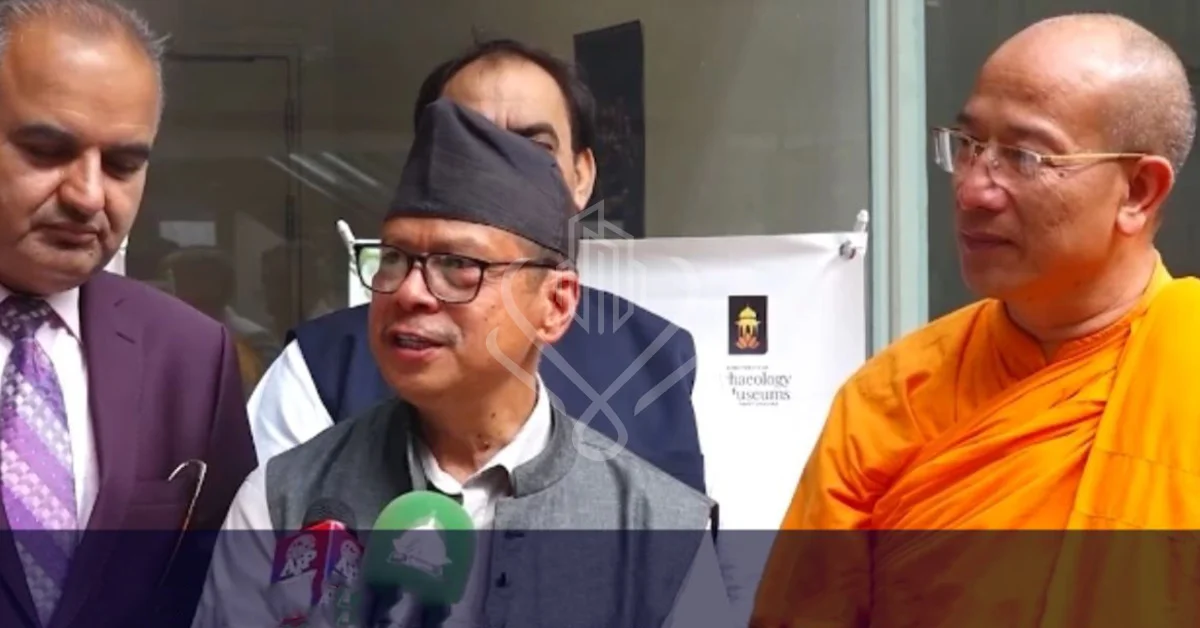
Taxila was a thriving center of monastic life, with countless monasteries dotting the countryside. These monastic institutions served as educational institutions where Buddhist scriptures, philosophy, and disciplines were taught and discussed, as well as spiritual havens for monks and nuns. The city’s renowned university fostered a generation of Buddhist scholars and practitioners, establishing Taxila as a preeminent center of Buddhist scholarship.
The Significance of Buddhism in Taxila and Its Influence on the City’s Growth and Development
In Taxila, Buddhism had a significant impact that influenced the growth and development of the city in numerous ways. As a substantial center of Buddhist study and practice, Taxila drew intellectuals, monks, and travelers from various nations, promoting cross-cultural interaction and intellectual stimulation. A well-known university and significant monastic institutions added to the city’s status as a learning center, attracting students and academics interested in the Buddha’s teachings. The steady stream of pilgrims and travelers improved the city’s intellectual climate and boosted its economy by making it a hub for trade and commerce.
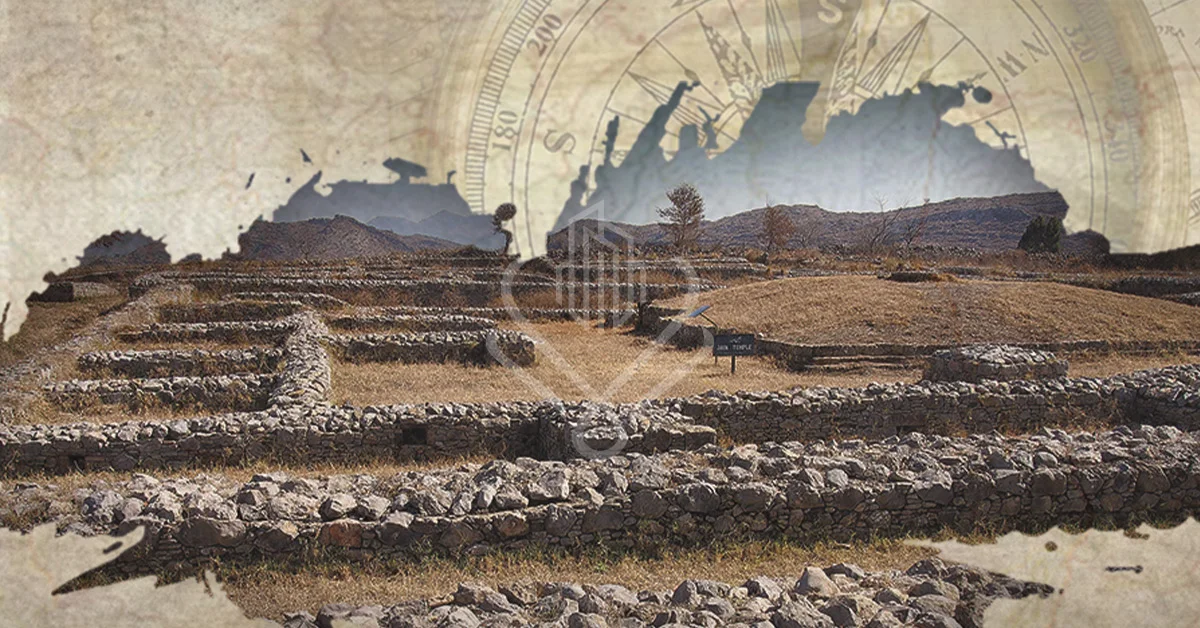
The Buddhist stupas and monasteries that dotted the countryside evolved into sites of artistic creation, exhibiting the diversity of the city’s cultures. Taxila flourished as a significant hub of scholarship, culture, and spirituality thanks to its connection to Buddhism. It left behind an everlasting legacy still celebrated through its archaeological heritage and the recognition of its enormous historical significance.
Highlight Vassa’s (Rain Retreat) Importance in Buddhist Monastic Traditions and the Reasons Behind its Observance
Vassa, sometimes called the Rain Retreat, is highly revered in Buddhist monastic traditions. Buddhist monks and nuns celebrate this annual three-month period of retreat, which starts with the full moon of the eighth lunar month and ends with the full moon of the eleventh lunar month. During the Rain Retreat, monastic groups congregate, stay put, abstain from travel, and partake in various activities. There are two primary motivations for observing Vassa. First, traveling monks were advised to stay in one location during the rainy season in ancient India to prevent unintentionally injuring small animals and plants.
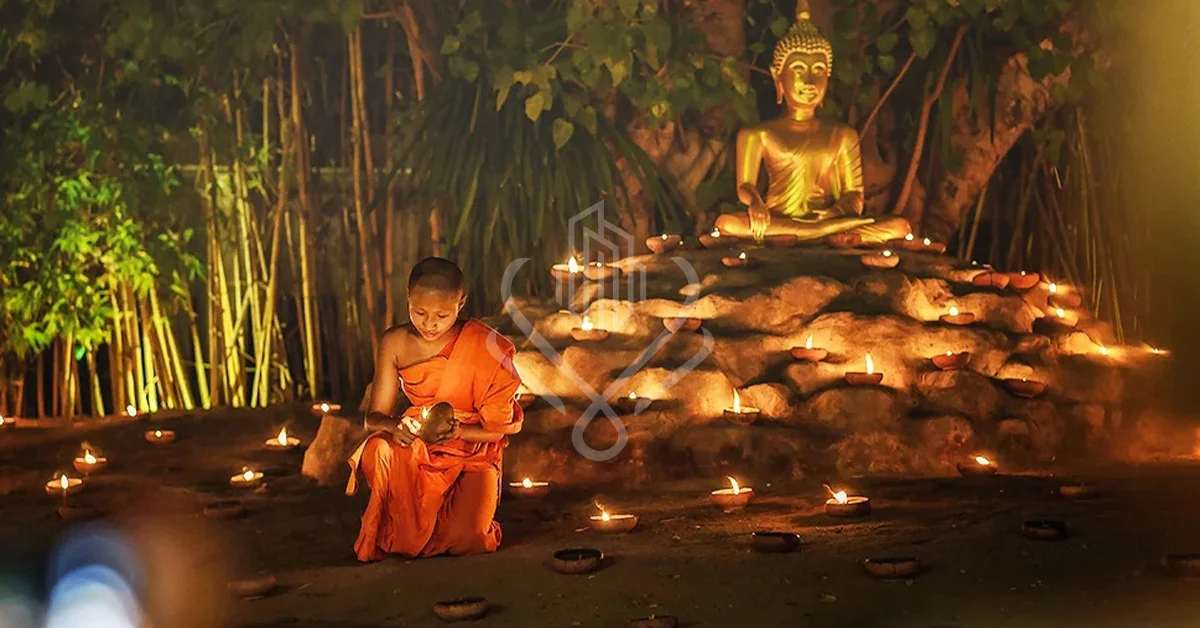
They might reduce their environmental impact by staying in one place. Second, the Rain Retreat allows intensive meditation, prayer, research, and introspection. It enables monks and nuns to develop their spiritual discipline, cultivate inner serenity, and learn more about Buddhist teachings. The monastic community strengthens its adherence to the spiritual path through Vassa, establishing a sense of cohesion and devotion to the Buddhist way of life.
Determining Rain Retreat 2565 BE
For the year 2565 BE (Buddhist Era) at Taxila, the time of the Rain Retreat, or Vassa would have required a combination of historical, astronomical, and conventional techniques. Ancient Buddhist monastic communities used astronomical occurrences and physical observations to determine the start of Vassa.
Moon cycle-based astronomical calculations were extremely important in calculating the precise timing of the Rain Retreat. To recognize the full moon of the eighth lunar month, which signaled the beginning of Vassa, monks, and academics would have monitored the moon’s and stars’ motions. The full moon of the eleventh lunar month marked the conclusion of the Rain Retreat.
Ancient calendars were also used to track the moon phases and determine the dates for Vassa, mainly Buddhist lunar calendars. The monastic community was able to synchronize its spiritual practices with the cyclical patterns of the universe thanks to these calendars, which were created to coincide with astronomical events.
Cultural and traditional aspects could have also influenced the choice of Rain Retreat. To further support the continuity of Buddhist practices in the area, certain monastic traditions and rituals in Taxila would have contributed to celebrating Vassa at a particular period of the year.
Investigate the Historical and Astronomical Methods Used to Determine the Specific Timing of the Rain Retreat for the Year 2565 BE
Buddhist monks typically stay in one location for three months during the rainy season for meditation and study. This period is known as the Rain Retreat, Vassa, or Buddhist Lent. It usually starts on the eighth lunar month’s full moon day and ends on the eleventh month’s full moon day.
Historical Approaches
Lunar Observations
Monks and academics previously timed the Rain Retreat according to their visual observations of the moon. To determine the start and finish of the retreat, they would use the full moon as a guide and lunar almanacs or astronomical tables as a resource.
Tradition and Oral Knowledge
Buddhist monastic communities have developed traditions and transmitted oral knowledge over the years to determine the precise timing of the Rain Retreat. The start date of the retreat may be decided by knowledgeable monks or elders using their understanding of astrological events.
Astronomical Methods
Lunar Calendar Calculations
Astronomical calculations are needed to predict moon phases precisely because the Buddhist calendar is predominantly lunar. The dates of full moons are indicated using intricate mathematical calculations utilizing the lunar synodic month and the moon’s speed.
Software and Computations
Today, thanks to technological advancements, astronomical algorithms and software are used to determine the precise timings of celestial occurrences, including the dates of full moons. These calculations are more accurate and can predict when the Rain Retreat will occur.
The Cultural and Spiritual Significance of Starting the Rain Retreat at the Precise Time
The Rain Retreat, sometimes called Vassa or Buddhist Lent, has enormous cultural and spiritual significance in Buddhist traditions. The Buddha’s teachings are firmly ingrained in the timing of the Rain Retreat, which has several significant ramifications.

Monastic Regulations
Buddhist monks and nuns adhere to more stringent monastic regulations during the Rain Retreat. They avoid long-distance travel and remain in one location, frequently a monastery. This enables individuals to concentrate on their spiritual practice, improve their meditation, and learn more about the Buddhist canon. Beginning the retreat at the exact time ensures that the monks adhere to these guidelines in tune with the lunar cycles and the environment’s natural rhythms.
Remembering The Buddha’s Teaching
The Rain Retreat’s schedule is based on the lunar calendar, which is thought to have been used by the Buddha to deliver many of his teachings. Beginning the retreat on the day of the full moon emphasizes the significance of the Buddha’s teachings and is a means to remember and honor his enlightenment and compassion.
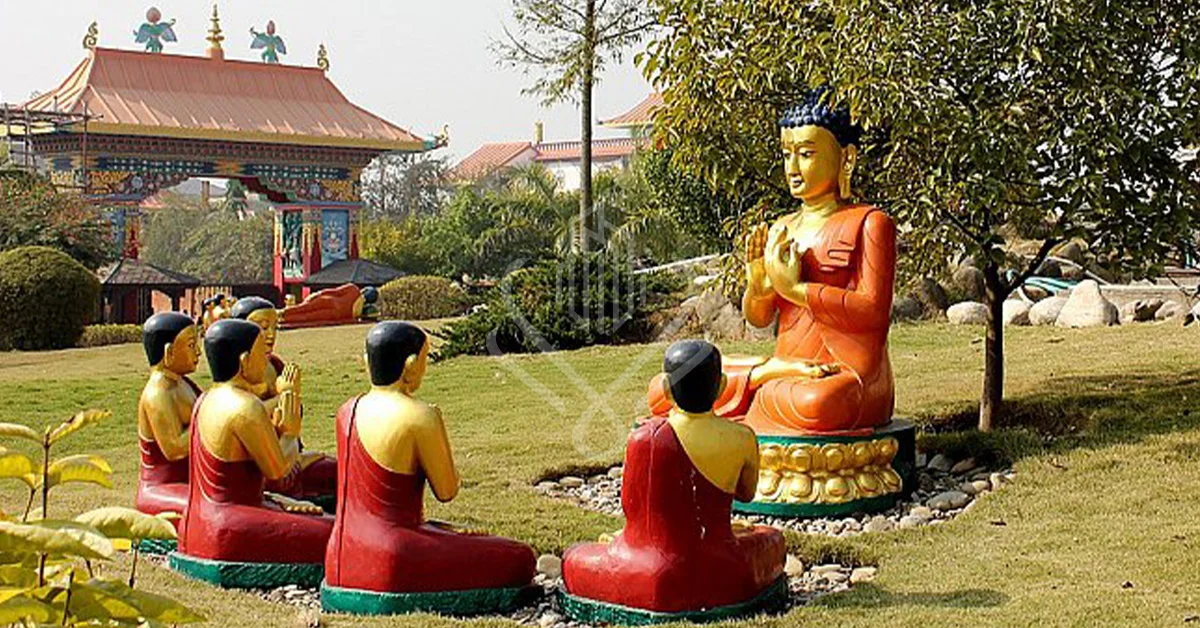
Emphasising Community and Unity
Buddhist monastic groups gather during the Rain Retreat to practice together. The monastic Sangha’s sense of common purpose and teamwork is strengthened by having the retreat begin at the same hour. In Buddhism, unity is a vital component of one’s spiritual development.

Respect for The Environment and Nature
The Rain Retreat occurs during the wet season in many Asian nations. Buddhist monks respect the environment and recognize the value of natural cycles by beginning the retreat at a precise time. The Buddhist idea of connectivity and non-harming (ahimsa) aligns with this practice of being in harmony with nature.

Developing Self-Restraint and Discipline
The Rain Retreat calls for self-control and discipline to abide by the monastic norms. Starting the retreat at the exact time highlights how vital dedication and commitment are to the spiritual path. It allows monks and nuns to evaluate their behavior and strengthen their commitment to moral behavior.

Symbolising Renunciation
Renunciation is symbolized by the Rain Retreat, commonly referred to as the “Rains Retreat,” because it is a time when monks retire from worldly activities and focus on their spiritual practice. Starting the retreat at that moment represents the act of renunciation and separation from material cravings, which helps people concentrate more intently on spiritual goals.
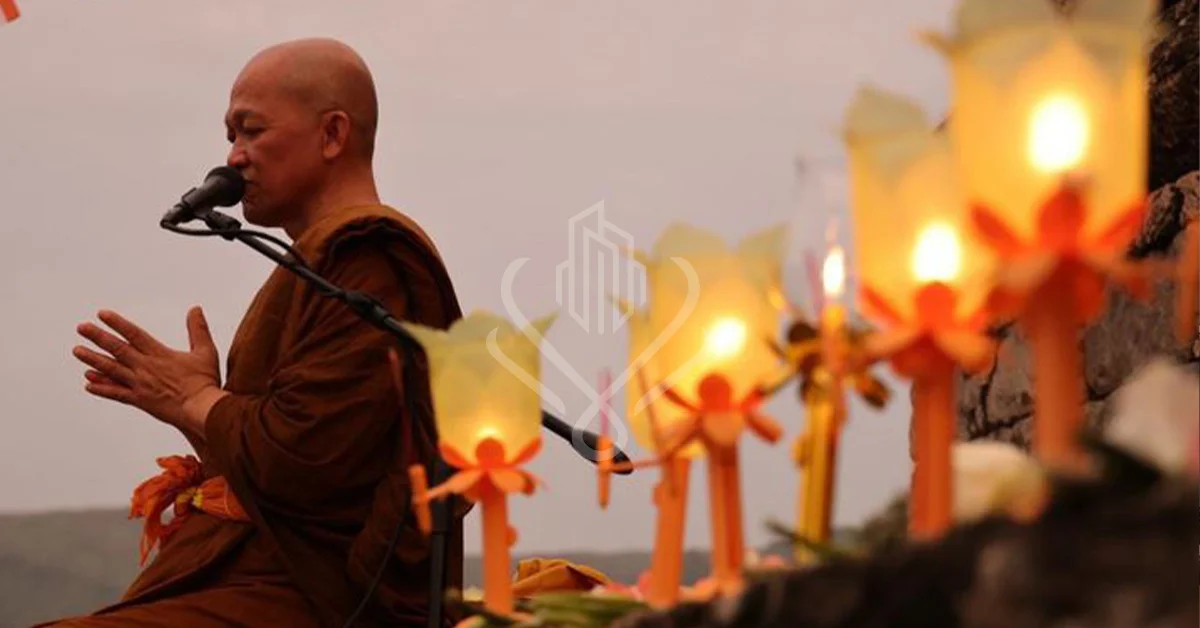
The precise timing of beginning the Rain Retreat is an essential component of Buddhist spirituality and culture. It encourages unity, self-control, and reverence for the natural world while giving monks and nuns a chance to deepen their spiritual practice and fully comprehend the Buddha’s teachings.
Reflections on Rain Retreat in Taxila
Given its longstanding Buddhist traditions, the Rain Retreat may have even more significant cultural and spiritual significance in Taxila. It is believed that during the Rain Retreat, Buddhist practitioners in the area upheld and honored the traditions of their ancestors who lived and practiced in Taxila centuries ago. Taxila was formerly a key center of Buddhist study.

The specific observations and comments on the Taxila Rain Retreat would rely on the regional customs, monastic traditions, and cultural backdrop prevalent in the area. It should be noted that Buddhist practices may vary across different communities.
Modern-Day Relevance
The Rain Retreat, sometimes called Vassa or Buddhist Lent, is still relevant in contemporary Buddhist communities worldwide. Although it has a strong historical heritage and ancient practice foundation, its significance and impact are still relevant in modern society for several reasons:
Spiritual Renewal
Buddhist monks and nuns get the chance to hone their spiritual practices at the Rain Retreat. It is a period of reflection, meditation, and study that enables practitioners to reaffirm their dedication to the Buddha’s teachings and achieve a more profound understanding of the Dharma.
Community and Unity
The Rain Retreat helps the monastic Sangha feel more connected and united. Monks and nuns develop close relationships, exchange knowledge, and encourage one another on their spiritual journeys by living together for three months at a time. Lay Buddhists who frequently support and contribute to the retreat have this sense of unity.
Ethical Discipline
The Rain Retreat strongly emphasizes ethical discipline and the observance of more stringent monastic regulations. Monks and nuns should take this opportunity to renew their commitment to leading simple, compassionate, and non-harming (ahimsa) lives. For adherents, this ethical emphasis is a helpful reminder to practice mindful and compassionate living.
Environmental Concerns
The Rain Retreat falls during the rainy season in many Asian nations. Buddhist monastics uphold the custom of staying put during this time to show their reverence for nature and the importance of coexisting peacefully with it.
Cultural Heritage
Buddhism’s rich cultural history remains preserved and honored at The Rain Retreat. It gives present practitioners a sense of continuity with and a connection to the origins of Buddhism by connecting them to the knowledge and customs of their predecessors.
Mindfulness and Meditation
The Rain Retreat promotes regular meditation practice and mindfulness. This emphasis on mindfulness might be especially pertinent in today’s fast-paced and distracted environment because it fosters mental clarity, emotional well-being, and stress reduction.
Personal Transformation
The Rain Retreat’s rigorous practice allows personal growth and self-discovery. It enables practitioners to face their difficulties, create inner serenity, and better comprehend who they are and the world they live in.
Renewed Commitment
For lay Buddhists, the Rain Retreat can be an opportunity to enhance their engagement with Buddhist communities and recommit to their spiritual path. During this time, many laity practitioners might practice meditation, study, and involvement in temple activities more frequently.
The Legacy of Taxila and Its Relevance in Contemporary World
For several reasons, the heritage of Taxila, a historic city and essential center of learning in modern-day Pakistan, is still very relevant today. Taxila is a site of significant interest and significance today because of its historical and cultural contributions to education, religious pluralism, and cultural interchange.
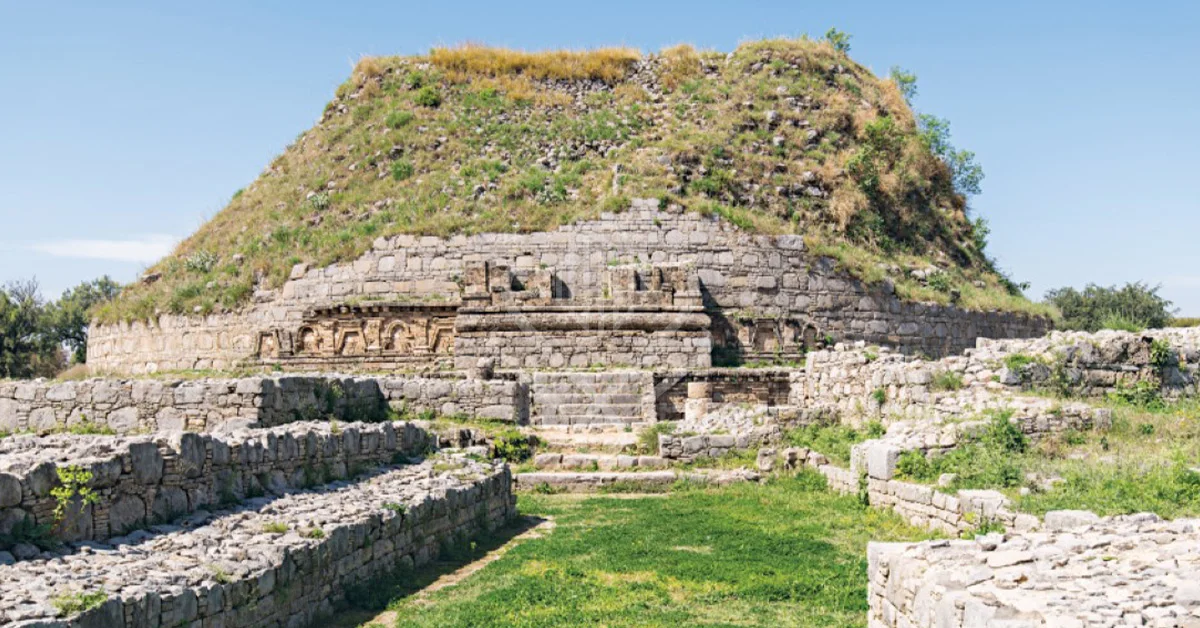
Legacy in Education
Taxila was a renowned center of learning in antiquity, drawing students and scholars worldwide. It was home to one of the first universities, which taught courses like philosophy, theology, medicine, maths, and astronomy. Its educational legacy emphasizes the significance of learning and academic endeavors, a principle that is still relevant in today’s society. Its acknowledgment of education as a foundational element of intellectual development and societal advancement gives it contemporary importance.
Religious and Cultural Diversity
Buddhism, Hinduism, and Jainism were only a few of the many religions and cultures in Taxila. People from different origins could live and learn together in the city because of the diversity of religions and cultures. The heritage of Taxila serves as a reminder of the value of celebrating variety and fostering interreligious understanding in today’s interconnected global society as we work to create inclusive and harmonious neighborhoods.
Trade and Cultural Interchange
Taxila was a key crossroads for East-West cultural interchange due to its advantageous placement on historic trade routes. It influenced the cultural advancements of diverse regions by facilitating the exchange of information, creativity, and ideas. This legacy is still relevant today because of how interconnection and globalization affect international relations and highlight the importance of intercultural dialogue and collaboration.
Architectural and Artistic Influence
Architectural and artistic influences can be seen in the excellent examples of ancient architecture and art that can be seen at Taxila’s archaeological monuments and ruins. The city’s legacy in this area emphasizes protecting cultural heritage and raising historical literacy. The significance of Taxila in the modern world is found in its contribution to the study of ancient civilizations and the motivation it offers for current architectural and creative endeavors.
Architectural and Artistic Influence
Sustainability Lessons: The ancient city of Taxila was constructed using water management principles, sustainable urban planning, and environmental awareness. A sophisticated water supply and drainage system may be seen in the ruins, demonstrating a knowledge of environmental stewardship. Taxila’s legacy can influence methods of urban design and environmental protection in the modern world, where sustainability and ecological concerns are important considerations.
Conclusion
In conclusion, a fascinating peek into this ancient city’s rich historical and cultural history has been made possible by investigating the mysteries of Taxila and examining the importance of the Rain Retreat in the year 2565 BE. The legacy of Taxila as a hub of study, religious variety, and cultural interaction has a significant impact on modern society. With its focus on spiritual regeneration, ethical discipline, and unity among Buddhist practitioners, The Rain Retreat is still relevant today. It provides insightful lessons in mindfulness, interfaith communication, and environmental stewardship.
Taxila’s timeless teachings and profound influence guide us to value knowledge, embrace variety, and foster a peaceful and sustainable global community as we explore the past to understand the present.
FAQs
Q1.What is the historical significance of Taxila, and why is it considered an ancient center of learning?
Ans. Taxila is historically significant as an ancient center of learning, attracting scholars from different regions to study subjects like philosophy, medicine, and mathematics.
Q2. How does the Rain Retreat in the year 2565 BC connect with the lunar calendar and the teachings of the Buddha?
Ans. The Rain Retreat in 2565 BE aligns with the lunar calendar’s full moon, following the tradition established by the Buddha, providing monks and nuns an intensive period for meditation and studying the Dharma.
Q3. What role does the Rain Retreat play in fostering unity and community among Buddhist monks and nuns in Taxila?
Ans. The Rain Retreat fosters unity and community among Buddhist monks and nuns in Taxila by encouraging them to stay in one place, deepening their bonds, and supporting each other in their spiritual journey.
Q4. How does the Rain Retreat in Taxila showcase the importance of environmental awareness and sustainable practices in ancient times?
Ans. The Rain Retreat in Taxila showcases the importance of environmental awareness and sustainability through its sophisticated water management systems and ancient urban planning that respected the environment.
Q5. How does the legacy of Taxila and its Rain Retreat hold relevance in the contemporary world, and what lessons can be learned from its historical and cultural contributions?
Ans. The legacy of Taxila and its Rain Retreat holds relevance in the contemporary world by inspiring education, interfaith dialogue, and cultural exchange. Lessons from their historical contributions can be learned about embracing diversity, preserving cultural heritage, and promoting sustainable practices for a harmonious global community.
Our Featured Article:
Read More: Unveiling The Marvels of Gandhara Civilization
Read More: Discover The Ancient Beauty of Gandhara: A Guide to Tourism in Pakistan
Don’t miss the chance to invest with Lakeshore! Secure your investment today by investing your financial investment with Lakeshore in the following available options like Lakeshore City, Lakeshore Club, and Lakeshore Farms.
For More updates, please Contact +92 335 7775253 or visit our website https://lakeshorecity.com/
Lakeshore City is the upcoming elite lifestyle at Khanpur Dam. Offering no parallel amenities for the members and owners of distinguished farmhouses.
Become Part of Luxurious Lifestyle
Contact: 0335 7775253


